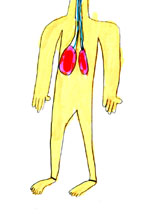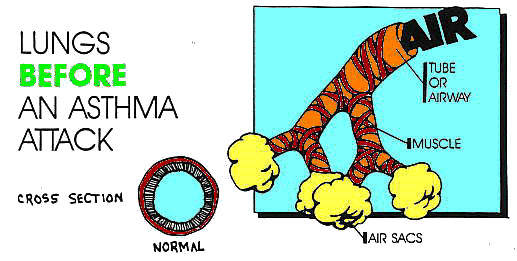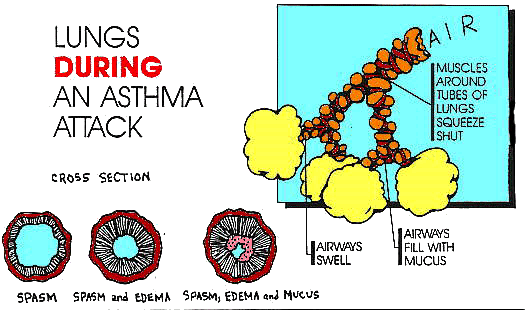 |
 |
|
| WHAT? WHY? SYMPTOMS? HOW? FEEDBACK FORM
|
When most of us breathe, the muscles that are wrapped around the air tubes (airways) are very loose and relaxed, and the lining inside the airways is very thin. This lets the airways open up very wide so that it is easy to get air in and out of the small air sacs that make up your lungs. These small sacs are called alveoli (pronounced al-vee-oh-lye). When air moves in and out of your lungs, we call it breathing.
The picture below shows what your lungs look like when everything is working normally. The muscles that are wrapped around the airways are very thin and loose, and the airway is wide open. This makes it easy to move air in and out of the air sacs.
During an asthma attack, the muscles around the airways tighten, or "spasm" (like when you make a fist) and the lining inside the airways swell or thicken, and get clogged with lots of thick mucous. This makes the airways much skinnier than usual so it is harder to move air in and out of the air sacs. This makes it hard to breathe! The picture below shows what your lungs would look like during an asthma attack.
During an asthma attack, it is actually harder to breathe out than it is to breathe in. This means that during an asthma attack, it takes much longer to breathe out (expire) than it does to breathe in (inspire)
Since it is so hard to breathe out during an asthma attack, more and more air gets trapped inside the lungs making it feel like you can't breathe in or out!
What causes asthma attacks?Lots of different things can cause an asthma attack. Something that causes an asthma attack is called a trigger. Some common triggers of asthma attacks are:
|
![]()
![]() Return to Children's
Medical Center Home Page
Return to Children's
Medical Center Home Page
![]()
![]() All contents copyright (C) 1994, Stephen M. Borowitz, Children's
Medical Center, University of Virginia. All rights reserved. Last revised:
October 20, 1999.
All contents copyright (C) 1994, Stephen M. Borowitz, Children's
Medical Center, University of Virginia. All rights reserved. Last revised:
October 20, 1999.

